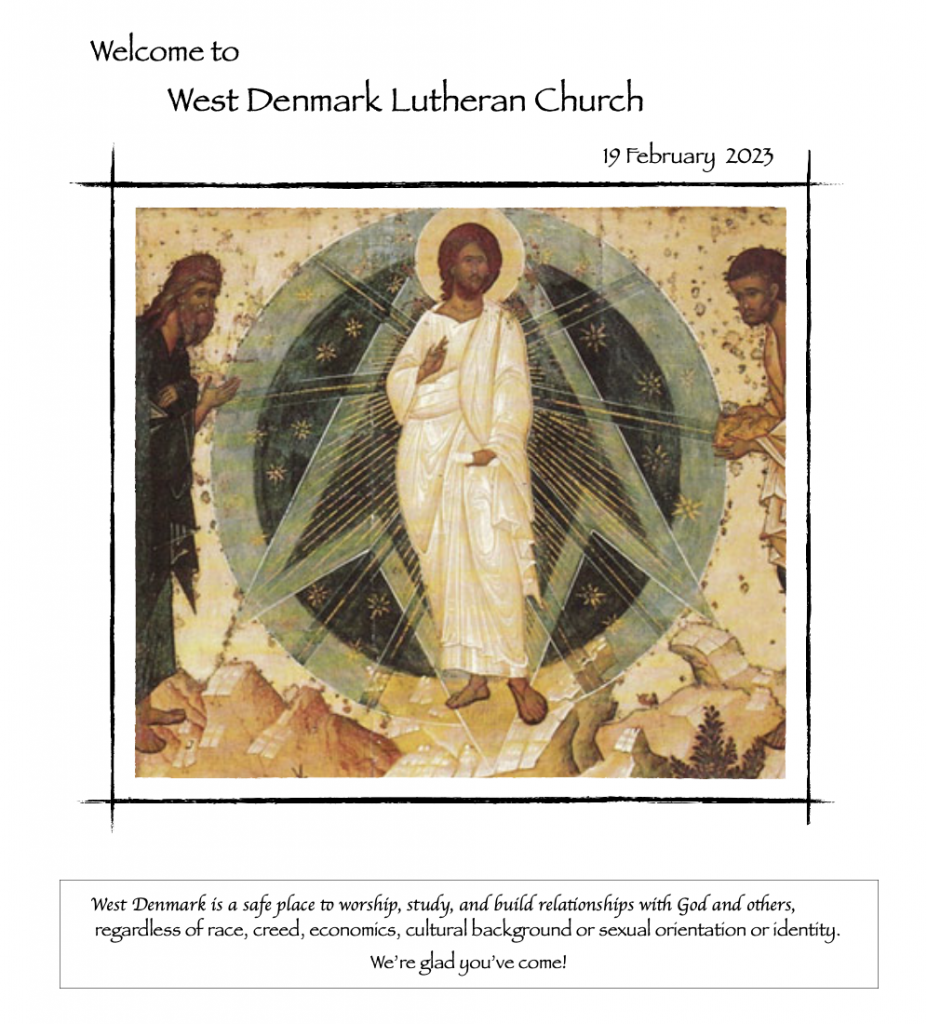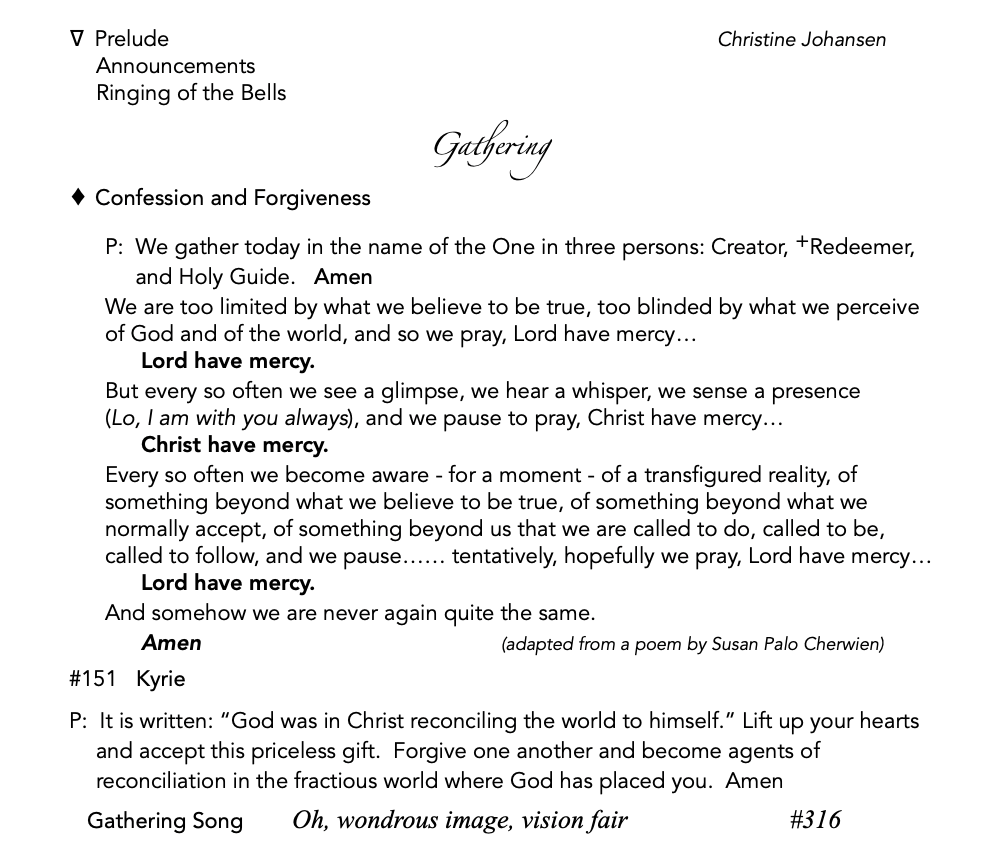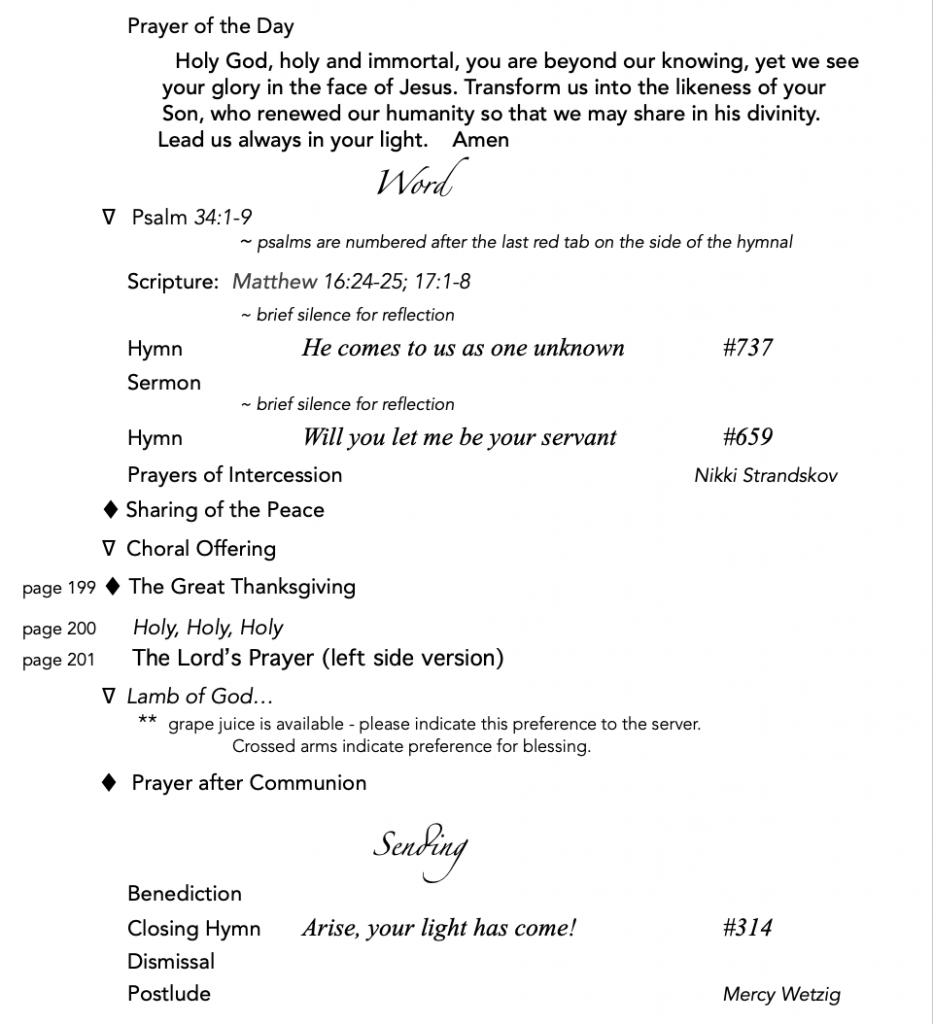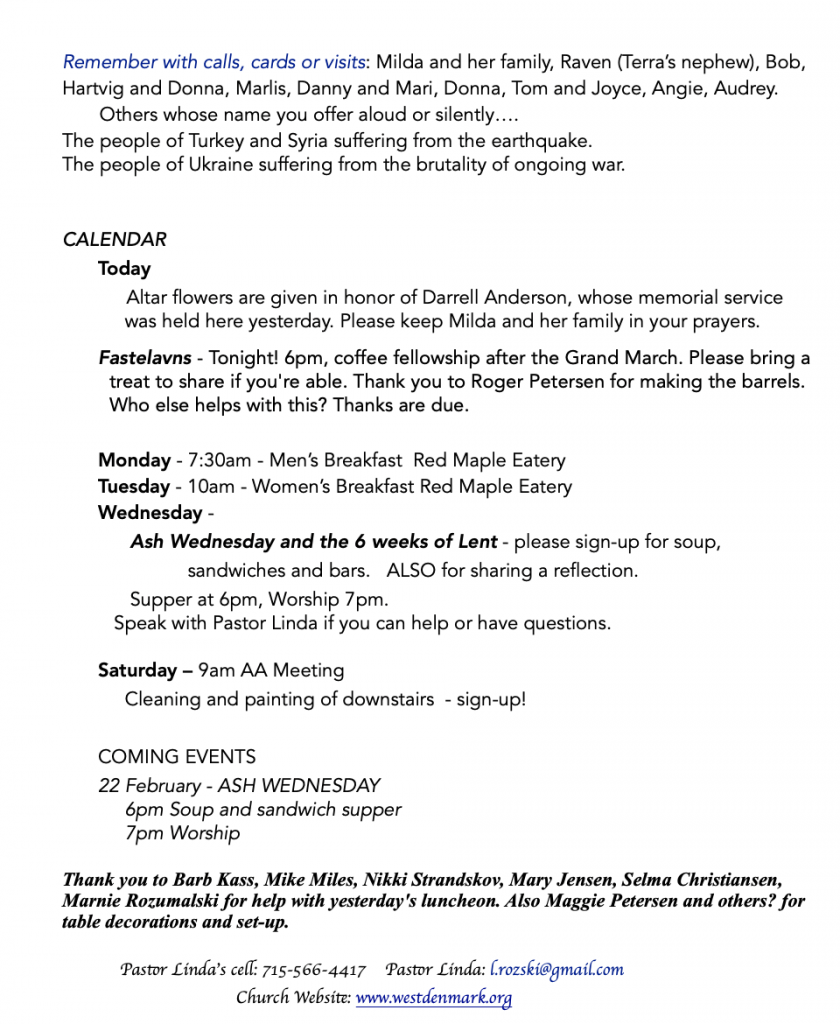Audio Recording



Matthew 16:24-25; 17:1-8
6:24 Then Jesus told his disciples, “If any want to become my followers, let them deny themselves and take up their cross and follow me. For those who want to save their life will lose it, and those who lose their life for my sake will find it.
17:1 Six days later, Jesus took with him Peter and James and his brother John and led them up a high mountain, by themselves. And he was transfigured before them, and his face shone like the sun, and his clothes became dazzling white. Suddenly there appeared to them Moses and Elijah, talking with him. Then Peter said to Jesus, “Lord, it is good for us to be here; if you wish, I will make three dwellings here, one for you, one for Moses, and one for Elijah.” While he was still speaking, suddenly a bright cloud overshadowed them, and from the cloud a voice said, “This is my Son, the Beloved; with him I am well pleased; listen to him!” When the disciples heard this, they fell to the ground and were overcome by fear. But Jesus came and touched them, saying, “Get up and do not be afraid.” And when they looked up, they saw no one except Jesus himself alone.
The gospel of Matthew is invested in building a case for the divinity of Jesus.
That might sound unnecessary because we’re so used to ‘knowing’ about Jesus’ divinity. We take it for granted. We’re used to the trinitarian formula – God the Father, Son, Holy Spirit – one God. We’re used to mushing all the gospels and their varying images and themes together into one theological meatball.
But the gospel of Mark, for example, speaks of Jesus as an emissary of God, a portal through which God’s way and will are made known. The emphasis in Mark is not on Jesus’ divinity, but on his faithfulness to God’s will that leads him to the cross.
Matthew has a different theological point to make.
Each gospel was written into a time warp. Looking back 50 or more years, written at least 15 years after the destruction of Jerusalem, they talk about people, events and structures which were no longer there. Matthew was written to a community of Greek-speaking Christian Jews who probably lived in Syria, likely in the city of Antioch.
His community was growing increasingly distant from the Pharisee-led Judaism of this new era in diaspora, and they were increasingly Gentile in their membership and outlook. It was written to proclaim Jesus as the Messiah, the unique son of God in a strongly pagan culture where the virgin birth of gods was not uncommon; where the gods dwelt on mountain tops and meddled somewhat maliciously in human affairs. It was written to bring the traditions, laws and promises of Hebrew scripture, of their God — who loved and prodded and guided and sacrificed for the sake of people — this God, into a new and diverse context.
We see evidence of this in the frequent quotes and references to the prophets, in reminders of events from Jewish history, in the images of Jesus as the new Moses, and in presenting Jesus as one who fulfills the Law.
Unlike the apostle Paul, who had died 20 years earlier, Matthew believed that Torah law was still in force. Matthew was likely written in the era of Emperor Domitian when Jews and the Christian Jews (and even members of his own Senate) were under threat. It was a time fraught with vying realities and claims of power.
The transfiguration is an important event within the gospel for all of these reasons. Jesus on a mountain top with clothes and face shining white is a reminder of Moses on the mountain receiving the Law – whose face shone so much that he had to wear a veil when he came back down to his people. It is a forecast of the glory to come – born out of the Jewish imagination and deep religious identity, and at the same time it would be familiar imagery within Greek and Roman mythology. The transfiguration story is a powerful bridge connecting all of Matthew’s community.
But, is it more than that? Is it more than a literary device? After all, there were only three witnesses and Jesus ordered them not to say anything about it. It could easily be a dramatic turning point created by the oral storytellers of Jesus’ life. From this point and forward, Jesus has turned his face and is aiming for Jerusalem and his death. It is the middle of the gospel, Jesus coming up for breath, as it were. He began on a mountain with the sermon on the mount, and will end on another mount, the hill of Golgotha. This episode echos God’s words at his baptism and the Centurion’s confession at the cross. It provides a solid literary structure, to be sure.
Often, miracles arouse my suspicious mind. What I think I know gets in the way of what I’m supposed to believe. Miracles raise all sorts of questions and skeptical responses in me.
But, perhaps oddly, I like epiphanies, theophanies, moments of God coming near, revelations of glory and wonder – wonder in the sense of awe, not of doubt. Moments of vision or clarity – of encounter – for some reason seem more believable. I’ve come to like this story of Jesus’ transfiguration – the glory of God bursting out in a blast with the holy ghosts of Moses and Elijah – the Law and Prophet – appearing like holograms from Star Wars. Life-altering experiences of insight, divine presence, and vision make sense to me.
Actually, the older I get, and the more left behind I am by technology, the less bothered I am by things that I can’t account for, that I can’t relate to or figure out. Computer algorithms that possibly know more about me than my friends and family do, bothers me, but in a helpless kind of way. I still can’t really understand radio waves, the uniqueness of snowflakes, or how infinite space can expand, or how kitchen scraps become garden soil.
There are lots of things that I don’t understand, that I can’t see with my own eyes, or give a rational explanation – but that I do, never-the-less, take on trust.
How do fiberoptic cables hold all of the movies I stream? How do sound waves recreate a particular voice with all of the subtleties of tone and inflection that makes it your voice? How is that transmitted exactly right so I know who’s calling by the time you’ve said “hello”? Why isn’t it interrupted by cars driving past, or trees blowing in the wind, or snow falling? How are my phone and computer sharing all things in common, but not with Marnie’s computer when she is sitting right next to me? Anyone?
We look out at a snowy landscape and we’re told that every single snowflake is unique in its shape, size or configuration. How do they know that? We look up at the stars and see dots of light and know intellectually that they are suns at all different depths of space, that space is actually full, it’s thick with energy and, though it’s infinite, it is expanding. Who wants to explain that to me?
I’ve read that two handfuls of healthy soil contain more living organisms than there are people on the earth. Two handfuls. Again, who is counting, and how? But believing that there is an unknown, unseen world beneath our feet upon whose health our planet’s survival depends, is … well, does it not transfigure dirt into glory? Do these wonderments not call our experience, our limited experience, of reality into question?
So, maybe Jesus did go up on that mountain with his disciples and was swallowed up in a bright cloud and it happened just the way they said it did. Maybe it’s true… like soil is true and stars and snowflakes and radio waves are true. The the point about miracles or epiphanies of God’s glory isn’t so much how they work or even about their truth, but rather about their meaning. What is the transfiguration story trying to communicate?
Two things, at least, which is maybe just one thing. As I said at the beginning, the gospel of Matthew is invested in building a case for the divinity of Jesus.
“…a bright cloud overshadowed them, and from the cloud a voice said, “This is my Son, the Beloved; with him I am well pleased; listen to him!” When the disciples heard this, they fell to the ground and were overcome by fear. But Jesus came and touched them, saying, “Get up and do not be afraid.” And when they looked up, they saw no one there except Jesus, alone.”
They go down the mountain and Jesus says, “By the way, don’t mention this to anyone,” and they get swallowed up in a crowd of people needing to be healed, and there are controversies with the Pharisees, and misunderstandings among the disciples, and Jesus keeps trying to teach them about radio waves and snowflakes and compost – the hidden and marvelous things of God.
BUT, the divinity of Jesus and the hidden, marvelous ways of God are one and the same thing. That’s what the disciples were supposed to see in this meeting on the mountain. They experienced the glory of God and then saw Jesus disappear into a crowd of people, engaging in the disputes and dealings and doubts of daily life.
The glory of God was visible on the mountain, but like Jesus’ lesson through the beatitudes, pointing out God’s favor-in-disguise despite the awkward appearance of real life and suffering, Jesus shows God’s glory even when he’s down the mountain, even when he’s tired and discouraged or eating and drinking with his friends and sinners – the ones with a past and with saucy stories to tell. God’s glory in Jesus shows then, too. It isn’t a white glow or the halo he’s painted with in religious art, but that’s the miracle – that God is present in Jesus in suffering and defeat and death, and is present with us when we can’t really believe it, can’t feel it, can’t see it …at all. God’s glory is hidden… dirty, lived, embodied.
Like those first disciples, we’re fascinated by the power plays, the flash and grandeur. We assume that glory means success and ease and smooth sailing and power. We like the view from the top of the mountain when the troubles of the world are far below, when people look like ants.
But Jesus insists on going down the mountain.
Transformation is a slow process – like compost creating glorious soil from coffee grounds and apple skins. But the work of Christ’s earthbound glory is to reconcile us to God and to one another, and to form us into fragile and resilient and useful vessels of his love and mercy for one another and the neighbor and the world. There is a cost, there will always be a cost, and we will, of course, encounter, and experience, and cause suffering. But, as Jesus said in the first verses of our reading, it is the way of the cross that leads us to life. It is those who give away and lose themselves in this life who are blessed to discover that they have actually found life.
Traditional theology, in an effort to maintain the divinity, says Jesus empties himself of glory, power, and status for the sake of a broken world. He leaves the things of God behind when he comes to us. I don’t think that’s right. I think that our hope rests on exactly the opposite being true – that Jesus brings the glorious, hidden, transformative power of God down the mountain and lets it get dirty.
It is here that God’s greatest glory is shown, here that the fullness of God’s love is poured out for us, here that Jesus shows us the glory – not of purified starlight and sunshine, but of unfathomable mercy and love – the messy glory of God for us, with us: Emmanuel.
Thanks be to God.
~ Pastor Linda
